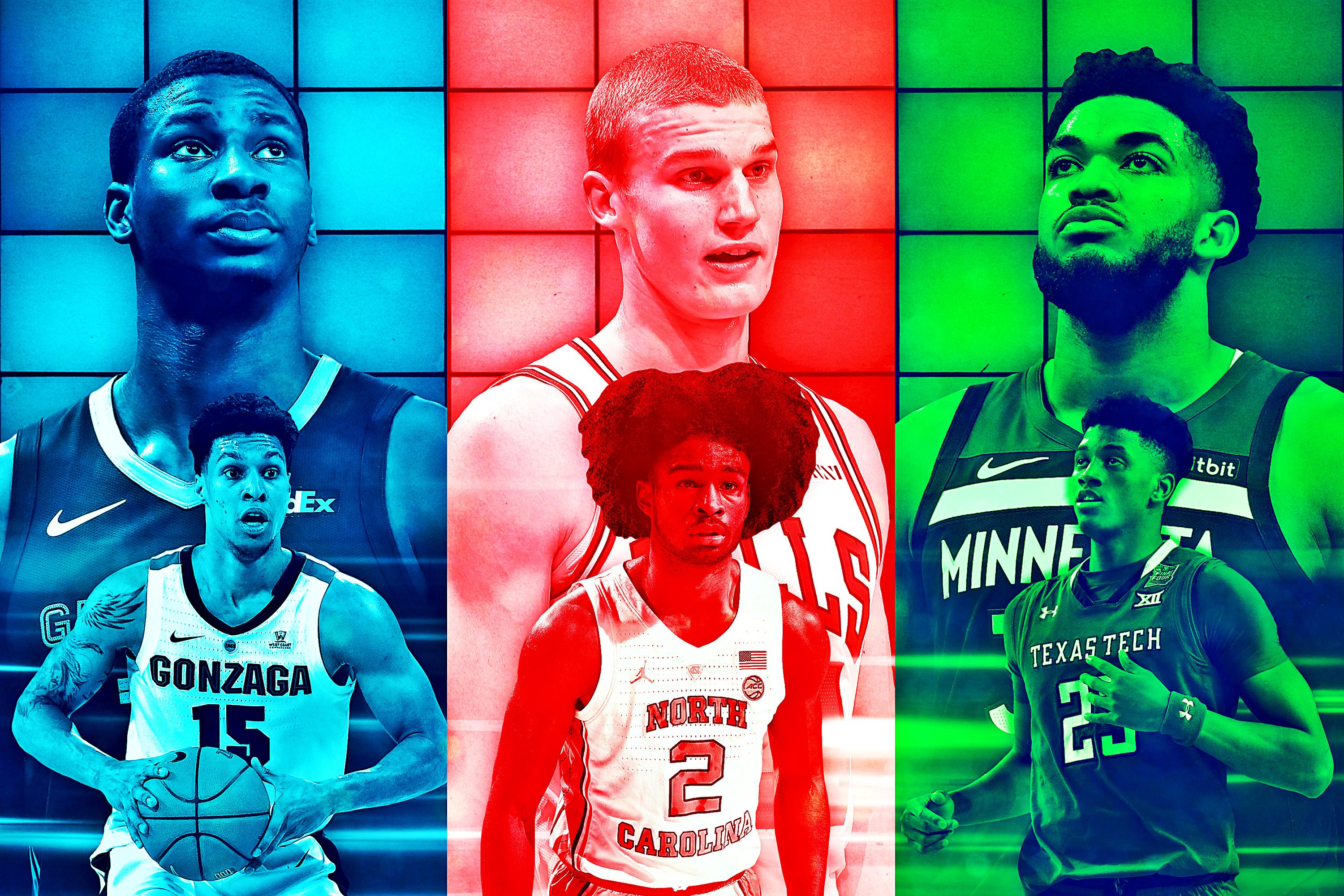
The most valuable type of big man in the modern NBA is a 7-footer with legitimate perimeter skills. There are still a few who can dominate out of the post, but the easiest way for centers to make life easier for their teammates on offense is to play at the 3-point line. Just look at what Brook Lopez did for the Bucks last season. The difference between Lopez and the next generation of great big men is that he changed his game halfway through his career to stay relevant. The best center prospects now come into the league with that ability. They are a new player archetype that teams are still figuring out how to build around. Three teams may have found answers to that question with the guys they took in this year’s draft:
- Wolves: Jarrett Culver (no. 6) with Karl-Anthony Towns
- Bulls: Coby White (no. 7) with Lauri Markkanen
- Grizzlies: Brandon Clarke (no. 21) with Jaren Jackson Jr.
Culver, White, and Clarke don’t have many similarities as players. None even play the same position. What they all have in common is their ability to complement a stretch big man. So much of whether a young player succeeds or fails in the NBA depends on the environment around them. Culver, White, and Clarke could end up as three of the biggest steals in the draft because they landed in such great situations.
How Jarrett Culver Complements the Timberwolves
Culver is a do-everything wing who skyrocketed up draft boards after a dominant sophomore season at Texas Tech, where he helped the Red Raiders get to the NCAA championship game. He was their best player on both ends of the floor, averaging 18.5 points on 46.1 percent shooting, 6.4 rebounds, 3.7 assists, and 1.5 steals per game. Culver has the size (6-foot-7 and 195 pounds) and athleticism to be a versatile defender at the next level, and he will give the Wolves another perimeter stopper next to Robert Covington and Josh Okogie. He could have just as big an impact on offense because he’s a smart player who can create shots for himself and his teammates by using his size to find cracks in the defense.
The big concern about Culver coming into the draft was his inconsistent 3-point shot. He was an average shooter from the 3-point line (34.1 percent on 4.1 attempts per game) in his NCAA career and a below-average shooter from the free throw line (68.7 percent on 4.2 attempts per game). He might have struggled if he had landed on a team that didn’t space the floor and needed him to be a spot-up shooter. He shouldn’t have to do that in Minnesota. Towns should attract so much defensive attention wherever he goes on the court that Culver will make a killing playing off of him. The Wolves big man is one of the most skilled players in the league, regardless of position. He averaged 24.4 points and 3.4 assists per game and was fairly close to being a 50/40/90 shooter last season: He shot 51.8 percent from the field, 40.0 percent from 3, and 83.6 percent from the free throw line.
Minnesota will be able to do a lot of creative things on offense with two such skilled players. Culver can run the pick-and-roll with Towns, post up smaller defenders when Towns is at the 3-point line, and cut off of Towns when he is playing in the post. Culver knows how to move without the ball and find open spots on the floor: He was the point forward in an unorthodox motion offense in college that featured a lot of cutting and screening. Towns will be able to find Culver, too. He is a much better passer than he is given credit for. He should be able to show it more now that everyone in Minnesota knows the offense goes through him.
Culver was the first draft pick of new Wolves GM Gersson Rosas, and his selection hopefully represents a change in philosophy in the type of players the team wants to put around Towns. Towns has spent the past few seasons playing with high-usage offensive players like Jimmy Butler, Andrew Wiggins, and Jeff Teague, who are most comfortable hunting for their own shot. He needs perimeter players who will run the offense and make sure he touches the ball instead of playing one-on-one and turning him into a spectator. He will love playing with an unselfish wing like Culver. It shouldn’t take long for the two to develop chemistry on both sides of the ball.
How Coby White Complements the Bulls
White, like Culver, rose up draft boards over the course of the season. He wasn’t originally supposed to be a one-and-done player, but it didn’t take long for him to show that he was the best prospect on a North Carolina team that had two other players (Cam Johnson and Nas Little) taken in the first round. White, a speed demon who pushes the pace at every opportunity, is a classic Roy Williams point guard. What makes him such an intriguing prospect is that he combines that speed with great size for the position (6-foot-5 and 185 pounds) and a good 3-point shot (35.3 percent on 6.6 attempts per game).
One of the knocks on White coming into the draft was that he might not be ready to run an NBA offense. He can make highlight-reel passes, but he’s still a score-first guard who can get out of control at times. Few coaches at the next level will give White as much freedom as he had under Williams. Bulls head coach Jim Boylen certainly won’t. The good news for White is that while his NBA coach may not be the best fit for his game, his teammates are. Markkanen is an even more prolific 3-point shooter than Towns: He shot 36.1 percent from 3 on 6.4 attempts per game last season, the most of any 7-footer in the league. White will be playing in spacing nirvana next to Markkanen.
It’s not just Markkanen, either. White will be the rare rookie point guard taken in the lottery who starts his NBA career with a lot of talent around him. Zach LaVine and Otto Porter Jr. are knockdown 3-point shooters, while Wendell Carter Jr. showed flashes of the ability to stretch the floor in a promising rookie season. The Bulls could run a five-out offense with shooters at every position. Porter and Carter, two of the better frontcourt passers in the league, can also take some of the playmaking pressure off of White. He won’t have to do everything on offense. He can play off the ball and count on his veteran teammates to create open shots for him.
White is a much better fit with their starters than Kris Dunn, a streaky outside shooter who can’t threaten the defense without the ball. Everything has to go through Dunn when he is in. White, on the other hand, is an excellent spot-up shooter who should be able to succeed in a smaller role in the offense. The Bulls don’t need their point guard to dominate the ball. They have two of the most skilled young big men in the NBA and two wings who can score in LaVine and Porter. For as much criticism as they have received during their rebuild over the past few seasons, they suddenly have one of the most interesting young cores in the league.
How Brandon Clarke Complements the Grizzlies
Clarke was even more unheralded than Culver and White coming into the season. He was a redshirt junior who had sat out a season after transferring from San Jose State to Gonzaga. He forced his way into the first round with one of the most dominant seasons in recent NCAA history: He averaged 16.9 points on 68.7 percent shooting, 8.6 rebounds, 1.9 assists, 1.2 steals, and 3.2 blocks per game. While his numbers have to be taken with a grain of salt because he was playing in the West Coast Conference, the Zags have also had plenty of future NBA big men (Domantas Sabonis, Kelly Olynyk, and Zach Collins) who were not able to come anywhere close to his level of production. He is a special talent.
To be sure, Clarke does have some downsides that could have reared their head in the wrong situation at the next level. The biggest is shooting. He took only 15 3s all season, and he rarely took shots outside of 15 feet. He needs to play on a team with enough 3-point shooting around him to allow him to play around the basket. The problem with projecting Clarke to the next level is that he has the offensive profile of a traditional big man and the measurements (6-foot-8 and 215 pounds) of an NBA wing. A player with his skill set needs to be paired with someone who can match up with bigger centers on defense and play at the 3-point line on offense. Or, in other words, a big man exactly like Jaren Jackson Jr.
Clarke and Jackson are a match made in basketball heaven. Defenses will have to pick their poison. Jackson (who shot 35.9 percent from 3 on 2.4 attempts per game as a rookie) can stretch them out to the 3-point line, and Clarke (who shot 70.5 percent from 2-point range on 9.7 attempts per game last season) will be able to dunk on almost anyone. Clarke’s numbers around the rim are no fluke. He’s a savvy player who combines jaw-dropping athleticism with a great touch on floaters and hook shots. Both big men will benefit from playing with Ja Morant, the no. 2 overall pick in this year’s draft, who will create open shots for them in the pick-and-roll in the half court and get out and run with them in transition.
The beauty of the team Memphis is building is that it could combine the best elements of Grit and Grind with Lob City. A frontcourt of Jackson and Clarke could be even better on defense than they are on offense. They are both elite shot blockers with the quickness to switch screens and stay in front of much smaller players on the perimeter, as well as the basketball IQ to cover for each other as help-side defenders in the rare times when they are beaten off the dribble. Jackson will probably start the game at power forward next to Jonas Valanciunas, who is expected to re-sign with the Grizzlies this summer, but the most interesting lineups will come when they downsize and move Jackson to the 5 and Clarke to the 4.

